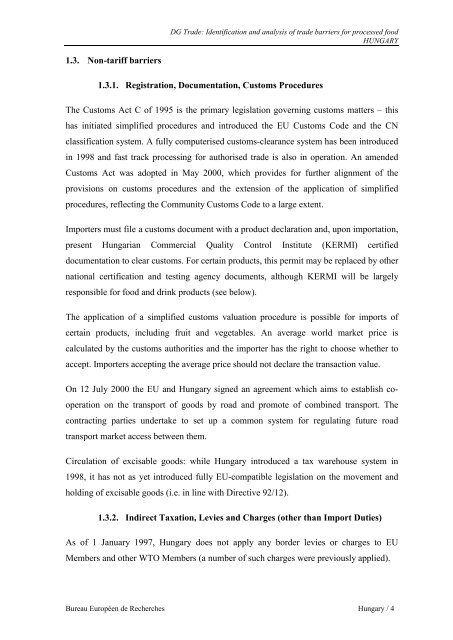HUNGARY Report.pdf - Agra CEAS Consulting
HUNGARY Report.pdf - Agra CEAS Consulting
HUNGARY Report.pdf - Agra CEAS Consulting
- No tags were found...
You also want an ePaper? Increase the reach of your titles
YUMPU automatically turns print PDFs into web optimized ePapers that Google loves.
DG Trade: Identification and analysis of trade barriers for processed food<strong>HUNGARY</strong>1.3. Non-tariff barriers1.3.1. Registration, Documentation, Customs ProceduresThe Customs Act C of 1995 is the primary legislation governing customs matters – thishas initiated simplified procedures and introduced the EU Customs Code and the CNclassification system. A fully computerised customs-clearance system has been introducedin 1998 and fast track processing for authorised trade is also in operation. An amendedCustoms Act was adopted in May 2000, which provides for further alignment of theprovisions on customs procedures and the extension of the application of simplifiedprocedures, reflecting the Community Customs Code to a large extent.Importers must file a customs document with a product declaration and, upon importation,present Hungarian Commercial Quality Control Institute (KERMI) certifieddocumentation to clear customs. For certain products, this permit may be replaced by othernational certification and testing agency documents, although KERMI will be largelyresponsible for food and drink products (see below).The application of a simplified customs valuation procedure is possible for imports ofcertain products, including fruit and vegetables. An average world market price iscalculated by the customs authorities and the importer has the right to choose whether toaccept. Importers accepting the average price should not declare the transaction value.On 12 July 2000 the EU and Hungary signed an agreement which aims to establish cooperationon the transport of goods by road and promote of combined transport. Thecontracting parties undertake to set up a common system for regulating future roadtransport market access between them.Circulation of excisable goods: while Hungary introduced a tax warehouse system in1998, it has not as yet introduced fully EU-compatible legislation on the movement andholding of excisable goods (i.e. in line with Directive 92/12).1.3.2. Indirect Taxation, Levies and Charges (other than Import Duties)As of 1 January 1997, Hungary does not apply any border levies or charges to EUMembers and other WTO Members (a number of such charges were previously applied).Bureau Européen de Recherches Hungary / 4













